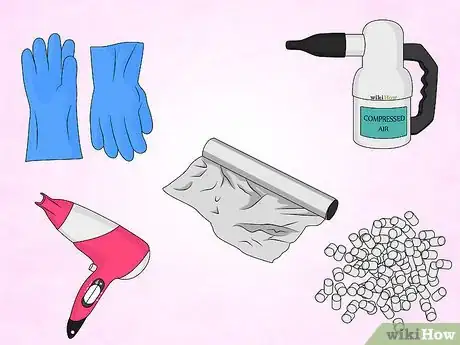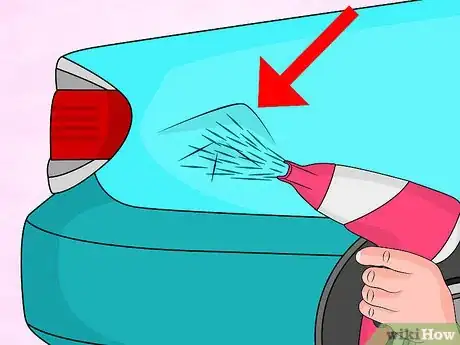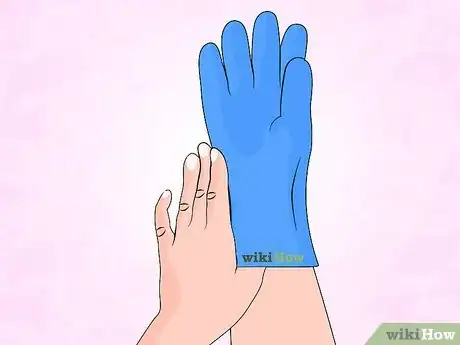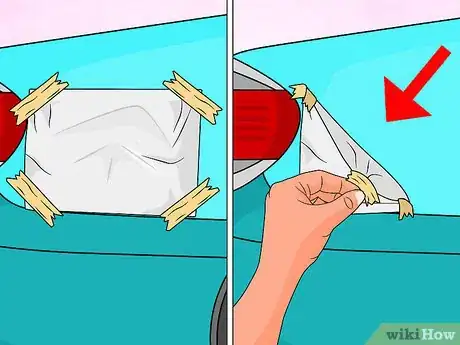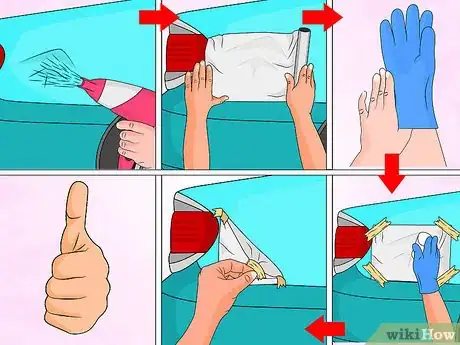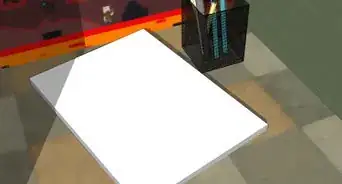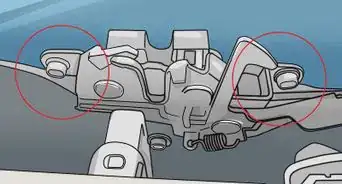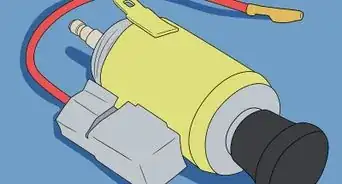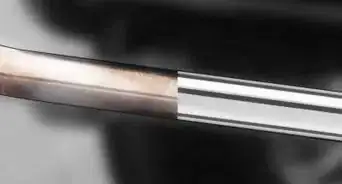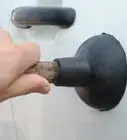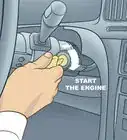This article was co-authored by Chad Zani. Chad Zani is the Director of Franchising at Detail Garage, an automotive detailing company with locations around the U.S. and Sweden. Chad is based in the Los Angeles, California area and uses his passion for auto detailing to teach others how to do so as he grows his company nationwide.
wikiHow marks an article as reader-approved once it receives enough positive feedback. This article has 11 testimonials from our readers, earning it our reader-approved status.
This article has been viewed 1,361,943 times.
Removing a dent from your car can sometimes be quite costly, especially if you take your car to an auto body repair shop. However, as an alternative you can repair and remove some kinds of dents from your car with the help of such common household items such as a hair dryer and either dry ice or a can of compressed air. Continue reading this article to learn how to remove dents from your car using these materials.
Steps
-
1Evaluate the dents. Dents can typically be removed using this method if they are located on the metal panels of the trunk, hood, doors, roof, or fenders, and are not right along the edges on broad flat surfaces.[1]
- To achieve the best results, use this method on shallow dents that do not contain major creases or paint damage, and that cover a surface area with a diameter of at least 3 inches (7.62 cm).
-
2Obtain the materials needed to remove the dent. You will need a hair dryer, heavy-duty or thick rubber gloves for safe handling of the dry ice or compressed air in its liquid format, aluminum foil, and either a package of dry ice or a can of compressed air. You will need some of the following:
- Heavy-duty insulated rubber-coated gloves.
- A full (or nearly full) can of compressed air.
- A package of dry ice.
- A hair dryer with adjustable temperature settings, such as "Low," "Medium," and "High," or "Cool," "Warm," and "Hot."
- Aluminum foil.
Advertisement -
3Apply heat to the dented panel. Turn on the hair dryer and use it to blow hot air over the dent and the surrounding area for one to two consecutive minutes.[2]
- The hair dryer should be set to medium and should be held between 5 and 7 inches (12.7 and 17.78 cm) away from the car's surface. Do not overheat the area in order to prevent the paint from becoming damaged due to overheating.[3]
-
4Insulate the dented area of the panel (if applicable). Place a sheet of aluminum foil over the top of the dented area. This step should only be performed if you are using dry ice instead of compressed air. The purpose of this step is to keep the area warm while also protecting the paint from the dry ice, which can potentially damage the topcoat.
-
5Put on the heavy-duty gloves. The gloves will protect you from frostbite and other injuries that can occur when your skin comes into contact with dry ice or liquified compressed air.
-
6Apply the dry ice or liquified compressed air. The rapid change in temperature from warm to cold will cause the surface of your vehicle to first expand (when heated) and then contract (when cooled).[4]
- If you are using dry ice, grab a block of the ice with one hand, then gently rub it over the aluminum foil resting on top of the dented area.
- If you are using a can of compressed air, turn the can upside down, and spray the surface of the dented area to cover the area with a layer of liquid ice. There are some basic principles of science at work here: the pressure, volume, and temperature of a gas are all interconnected. While normally the can loses temperature as the gas is released, if you spray the can upside down the gas itself is cooled.[5]
- Either method will only require a brief application. The surface panels of most modern vehicles are made of relatively thin and lightweight material and they will cool very quickly. You will likely not see any change after the first 30-50 seconds of application (or probably even sooner than that).
-
7Wait for a little while. A few moments after you have applied the dry ice or compressed air, you may hear a popping sound that will indicate the dent has been removed. The rapid temperature shift will usually make the material reform its original shape.
- If you used dry ice, remove and dispose of the aluminum foil after the dent has been removed.
- If you applied liquid ice by means of compressed air, wait for the white foam to dissipate from the surface of the car, then wipe residue away with a gentle cloth.
-
8Repeat the process as needed. For certain dents a single application may not be enough. If you see improvement but a dent is still noticeable, you can begin the process of heating and cooling again. However, do no overuse this process (especially in a single day). While the rapid temperature changes can reshape your car exterior, the extreme cold is potentially hazardous to the paint.
Community Q&A
-
QuestionWhere can I buy "compressed air"?
 Community AnswerCompressed air can be found in many stores that have office supplies or art supplies and can be ordered online.
Community AnswerCompressed air can be found in many stores that have office supplies or art supplies and can be ordered online. -
QuestionDoes this only work with fiberglass portions of the car, or can it also work with metal?
 Community AnswerIt works with metal too. Blowing with the hair dryer alone won't fix anything; once you heat the metal up enough with the hair dryer you have to push the metal from the inside of the dent outwards towards its original position until it gently pops back into place. Turn off the hair dryer and don't use the car for at least half an hour afterwards.
Community AnswerIt works with metal too. Blowing with the hair dryer alone won't fix anything; once you heat the metal up enough with the hair dryer you have to push the metal from the inside of the dent outwards towards its original position until it gently pops back into place. Turn off the hair dryer and don't use the car for at least half an hour afterwards. -
QuestionHow can you pull a dent out of a plastic bumper?
 Community AnswerHeat up the damaged area, put on a thick leather glove, and push out the dent while holding pressure on the dent. Take a cold rag soaked in ice water and rub it over the heated area.
Community AnswerHeat up the damaged area, put on a thick leather glove, and push out the dent while holding pressure on the dent. Take a cold rag soaked in ice water and rub it over the heated area.
Things You'll Need
- Hair dryer with multiple settings
- Thick heavy-duty gloves
- Package of dry ice or can of compressed air
- Aluminum foil
- Soft cloth
References
- ↑ http://www.autos.com/auto-repair/how-to-remove-car-dents-with-dry-ice
- ↑ https://lifehacker.com/macgyver-tip-fix-a-dent-with-canned-air-and-a-hair-dry-254575
- ↑ https://www.carsdirect.com/car-repair/how-to-repair-car-hail-damage
- ↑ http://www.mikesenese.com/DOIT/2010/12/car-dent-fix-blowdryer-compressed-ai/
- ↑ http://chemwiki.ucdavis.edu/Physical_Chemistry/Physical_Properties_of_Matter/Phases_of_Matter/Gases/The_Ideal_Gas_Law
About This Article
To remove a dent in a car with a hair dryer, start by applying heat to the dent with a dryer held 5-7 inches away from the car. Then, place a sheet of aluminum foil over the dent, and put on a pair of thick rubber gloves. Pick up a piece of dry ice and rub it over the dented area for 30-50 seconds. Remove the aluminum foil to inspect the area, and repeat the process of heating and cooling if the dent is still present. For information on evaluating the dent and using liquid compressed air, keep reading!

